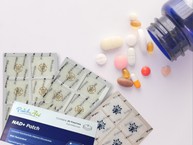Weight loss is hard. It is hard to find anyone who will dispute that! Even harder than losing weight can be losing it long-term. It is more common to stop losing weight, or to regain the weight, than to keep losing weight.
Thankfully, there are some strategies that can support successful long-term weight loss. They actually work, and they don’t involve dangerous diets or extreme sacrifices. Instead, they involve planning, small changes, and supporting your body with aids such as the Natural Weight Loss Enhancer Patch by PatchAid. Just be sure to talk to your healthcare provider before starting any weight loss program or using a dietary supplement.
Get ready.
How are you going to lose weight? Making a plan gives you something to go by. It also helps you identify what you will need as you go on your weight loss journey, so you can get it before you need it.
These are some things to consider when you are getting ready to lose weight.
- Who is in your support system? Family members, friends, healthcare providers, coworkers, and neighbors are all possibilities.
- What lifestyle changes will you make to lose weight? Eating differently, being active, getting more sleep, and managing stress can all help.
- What are your goals? Some goals may be weight loss, while other goals may be related to actions such as eating healthier.
Identify your motivation.
Most people have many motivating factors for losing weight. Long-term factors may include living longer, preventing chronic conditions or delaying complications from chronic conditions by managing them well, and being around to see milestones in the lives of children or grandchildren.
In the short term, reasons to lose weight can include having more energy, feeling happier, and looking better. Making a list of your motivations can help you lose weight and stay on track when times get tough.
Make small changes.
The great news is that long-term weight loss can happen with small changes. These are a few examples.
- Drinking water instead of soda.
- Ordering small instead of medium or large burgers, fries, or other menu items.
- Walking 30 minutes an extra three days a week.
- Having half of your usual serving of dessert.
- Eating more vegetables most days.
- Cutting fat off of meat and skin off of poultry.
You do not need to deprive yourself to lose weight.
Stay physically active.
The general goal for health is to get at least 150 minutes per week of moderate-intensity activity, such as brisk walking. For sustained weight loss, more may be better, as long as your doctor agrees. Walking, hiking, dancing, playing soccer, aerobics, and taking group fitness classes all count.
Stay nourished.
You may be trying to lose weight, but it’s important to keep your nutrient intake up. Protein can help keep you full and maintain lean muscle mass. High-fiber foods tend to be nutritious as well, and getting a full range of vitamins and minerals is necessary for keeping your metabolism up and your body running strong. Fish, vegetables, whole grains, fruit, beans, and a small amount of healthy fats are all good to include.
Learn to create a smart plate.
It’s hard to monitor every bite that you eat, to measure each portion, or to count everything you eat. But what you can do is follow a simple pattern that lets you eyeball smart portions and guides you towards the best foods for weight loss.
There are a few possible methods, but one easy one is the Plate Method. With this strategy, all you do is mentally divide your plate into 3 sections.
- Section 1 takes up half of your plate. It includes vegetables most meals, and fruit sometimes. You might have salad, steamed vegetables, or fresh fruit, for example.
- Section 2 takes up one-quarter of your plate. It includes a serving lean protein, such as low-fat cottage cheese, fish, skinless chicken, tofu, egg whites, or beans.
- Section 3 takes up one-quarter of your plate. It has a high-fiber carbohydrate. That can include a whole-grain, such as oatmeal, brown rice, whole-wheat bread, whole-grain pasta, or whole-grain unsweetened cereal. Or, it could include a starchy vegetable, such as sweet potato, acorn squash, peas, corn, or potato.
With this guidance, it is not burdensome to choose the right foods in amounts that make sense for keeping off extra pounds.
Plan for setbacks.
Setbacks will happen. They can take many different forms. Examples include plateaus, or not losing weight for a while, as well as challenges such as being too busy, going on a trip, or losing motivation.
What will you do when times get tough? It is helpful to think ahead to when that may happen, and to make a list of possible solutions, such as the following.
- Reach out to people who are part of your support system.
- Look back at your list of motivating factors and see if any have changed.
- Change your goals to be more realistic, more relevant, or more motivating.
- Log your food carefully to see if you may be eating things that you did not realize.
- Weigh yourself regularly.
Support your efforts with a vitamin patch.
Weight loss may be easier with the strategies, but it is still good to make sure you get the most from your efforts. The Natural Weight Loss Enhancer Patch by PatchAid has ingredients that are natural and related to metabolism and other support.* It has B vitamins, which are needed for normal energy levels, as well as apple cider vinegar, blue-green algae, bromelain, and kelp.
It is easy to use the Natural Weight Loss Enhancer Patch by PatchAid. All you have to do is apply it and leave it on for up to 8 hours. It comes in clear and white options and can be perfectly discreet.
*The Food and Drug Administration has not evaluated these statements. PatchAid patches are not intended to diagnose, treat, cure or prevent any disease. Anyone with a medical condition should seek the advice of a licensed medical practitioner. Individual results may vary.







